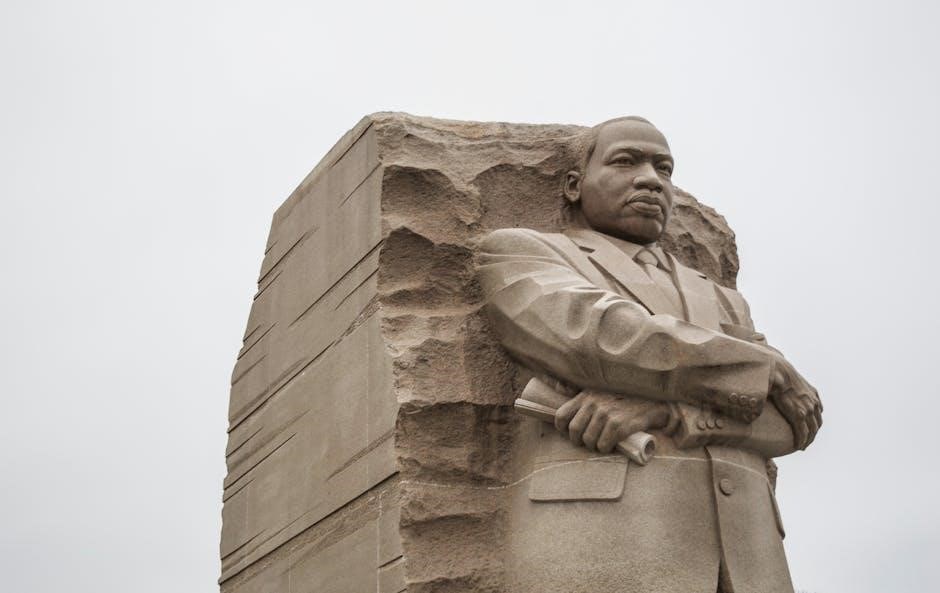Martin Luther’s 95 Theses, published in 1517, criticized Catholic Church practices, sparking the Reformation․ This document challenged indulgences, inspiring widespread religious and social change across Europe․

Historical Context and Background
In the early 16th century, the Roman Catholic Church faced growing criticism for its practices, including the sale of indulgences․ This system, which allowed individuals to purchase forgiveness for sins, was heavily promoted by figures like Johann Tetzel․ Martin Luther, a German monk and theologian, was deeply troubled by this practice, seeing it as a corruption of Christian doctrine․ The Church’s wealth and power had also led to widespread dissatisfaction among both clergy and laity․ By 1517, the stage was set for a confrontation; Luther’s 95 Theses emerged from this context, challenging the Church’s authority and sparking a theological and social movement that would forever alter Europe․
Luther’s Intentions and Motivations
Luther’s primary motivation was to reform the Church from within, not to divide it․ He sought to address what he saw as abuses of power, particularly the sale of indulgences, which he believed undermined genuine repentance and faith․ His intention was to provoke a theological debate among scholars and clergy, hoping to correct these practices through dialogue․ Luther’s deep commitment to Scripture and his belief in the priesthood of all believers drove his desire for spiritual renewal․ He aimed to restore the Church’s focus on biblical teachings and ensure that salvation was attainable through faith alone, rather than through material transactions․ His actions were rooted in a passionate love for the truth and a concern for the spiritual well-being of the faithful․
The Publication and Spread of the 95 Theses
Martin Luther’s 95 Theses were published on October 31, 1517, sparking widespread debate․ The printing press enabled rapid dissemination, spreading Luther’s ideas across Europe and fueling the Reformation․
The Date of Publication: October 31, 1517

On October 31, 1517, Martin Luther posted his 95 Theses on the door of the Castle Church in Wittenberg, Germany․ This act is widely regarded as the catalyst for the Protestant Reformation․ Luther’s theses criticized the Catholic Church’s practice of selling indulgences, which he believed undermined genuine spiritual repentance․ The document, written in Latin, was intended to spark theological debate among scholars․ However, its impact extended far beyond academia․ The theses were quickly translated into German, making them accessible to the broader population․ This marked the beginning of a movement that would challenge Church authority and reshape Christianity․ The date of October 31, 1517, remains a pivotal moment in religious and historical memory․ Luther’s bold action continues to symbolize the pursuit of reform and spiritual renewal․ The legacy of this day endures, inspiring reflection on faith and societal change․ The 95 Theses became a cornerstone of Protestant theology, emphasizing individual faith and scripture over institutional power․ The anniversary of their publication is celebrated as a turning point in Christian history․ Luther’s initiative not only questioned Church practices but also empowered individuals to seek a direct relationship with God, free from mediation․ The event’s significance is undiminished, offering lessons on the power of ideas to transform societies․ The 95 Theses remain a testament to the enduring influence of Luther’s vision and the Reformation’s lasting impact on the world․
The Role of the Printing Press in Dissemination
The printing press played a pivotal role in spreading Martin Luther’s 95 Theses across Europe․ Before its invention, ideas disseminated slowly, but Gutenberg’s press enabled rapid production of written materials․ Luther’s theses, initially written in Latin, were quickly translated into German and other languages, reaching a broad audience․ The press allowed thousands of copies to be printed and distributed, ensuring the document’s widespread circulation․ This technological advancement empowered reformers to share their ideas efficiently, bypassing traditional Church controls․ The printing press not only accelerated the spread of Luther’s critiques but also facilitated the broader dissemination of Protestant ideology․ Its impact was revolutionary, enabling the Reformation to gain momentum and transform Christianity․ Without the printing press, the 95 Theses might have remained a localized theological debate, never reaching the masses who embraced its message․ This innovation became a cornerstone of the Reformation’s success, reshaping religious and cultural landscapes․ The printing press democratized access to information, empowering individuals to engage with Luther’s ideas and sparking a movement that would forever alter Christian history․ The ability to mass-produce and distribute the 95 Theses ensured that Luther’s call for reform reverberated across Europe, leaving a lasting legacy․ The press’s role in spreading the theses underscores the power of technology to amplify ideas and drive societal change․ This era marked the beginning of a new age in communication, where ideas could spread swiftly and challenge established authority․ The printing press became an indispensable tool for reformers, enabling them to propagate their message and inspire widespread transformation․ Its influence continues to be felt, as it laid the groundwork for modern media and the dissemination of knowledge on an unprecedented scale․

Key Arguments and Criticisms in the 95 Theses
Martin Luther’s 95 Theses criticized Church practices, particularly indulgences, arguing they undermined true repentance․ He asserted Christ’s sacrifice sufficed for forgiveness, challenging papal authority and sparking Reformation․
Theses 1-50: Critique of Indulgences and Church Practices
The first fifty theses of Martin Luther’s document primarily targeted the abuse of indulgences․ Luther argued that the practice, which allowed people to purchase forgiveness for sins, was both corrupt and contrary to biblical teachings․ He contended that true repentance came from inner faith and spiritual devotion, not monetary transactions․ Luther also criticized the Church’s emphasis on material wealth, questioning why the Pope did not use his riches to build St․ Peter’s Basilica himself․ These initial theses laid the groundwork for his broader critique of Church authority and practices, challenging the notion that the clergy held exclusive power over salvation․ Luther’s arguments resonated with many, fueling widespread dissatisfaction and setting the stage for the Reformation․
Theses 51-95: Call for Reform and Spiritual Renewal
In the latter half of his theses, Luther shifted focus from critique to advocating for spiritual renewal․ He emphasized that true repentance comes from inner faith and devotion, not indulgences․ Luther called for a return to biblical teachings and criticized the Church’s prioritization of wealth over spiritual well-being․ He argued that the Pope and clergy should guide believers toward genuine faith rather than profiting from indulgences․ Luther also highlighted the importance of Christ’s example, urging Christians to follow His teachings rather than relying on Church practices․ These theses laid the foundation for broader reforms, challenging the Church’s authority and advocating for a more personal, faith-centered approach to Christianity․ Luther’s call for renewal resonated widely, inspiring transformative changes in religious and societal structures across Europe․ His ideas continue to influence Christian thought to this day․


Response to the 95 Theses

The Catholic Church and Pope Leo X strongly opposed Luther’s critique, leading to his excommunication․ Tetzel countered with 106 theses, intensifying the theological conflict and schism․
The Catholic Church’s Reaction and Counter-Theses
The Catholic Church initially dismissed Luther’s criticisms but grew concerned as his ideas gained traction․ Pope Leo X demanded Luther retract his statements, and when he refused, the Church excommunicated him in 1521․ Johannes Tetzel, a prominent defender of indulgences, responded with 106 counter-theses, condemning Luther’s views․ The Church’s rigid stance and refusal to reform alienated many, while Luther’s supporters grew more vocal․ This theological clash deepened the divide, leading to the polarization of Europe and the rise of Protestantism․ The Church’s reaction not only failed to suppress Luther but also highlighted its own corruption, further fueling the Reformation movement․

Luther’s Legacy and the Spark of the Reformation
Martin Luther’s 95 Theses ignited the Reformation, reshaping Christianity and European society․ His defiance against Church practices inspired widespread dissent, leading to the emergence of Protestantism․ Luther’s emphasis on individual faith and scripture challenged traditional authority, fostering theological and cultural transformation․ The Reformation’s ripple effects extended beyond religion, influencing education, governance, and social structures․ Luther’s legacy endures as a symbol of courage and reform, celebrated during the 500th anniversary in 2017, where his ideas were revisited with fresh perspectives․ His work remains a cornerstone of Protestant theology, ensuring his impact continues to resonate in modern times, highlighting the enduring relevance of his critique and vision for spiritual renewal․
Modern Relevance and Interpretation
The 95 Theses remain influential, with contemporary scholars exploring Luther’s ideas through new methodologies and diverse perspectives, ensuring their relevance in modern religious and cultural discourse․
The 500th Anniversary Celebrations and New Perspectives

In 2017, the 500th anniversary of Luther’s 95 Theses sparked global celebrations and renewed academic interest․ Events like symposiums and exhibitions highlighted the Reformation’s legacy․ Modern scholars explored Luther’s theology with fresh methodologies, incorporating diverse voices and contemporary issues․ The anniversary also prompted new publications, such as annotated editions of the 95 Theses, offering deeper insights into Luther’s arguments․ These efforts have made his ideas more accessible, fostering dialogue across faith communities․ The celebrations underscored the enduring impact of Luther’s critique, bridging history with modern religious and cultural discourse․
The Ongoing Influence of Luther’s Ideas
Martin Luther’s 95 Theses continue to shape modern theology and cultural thought․ His critique of indulgences and emphasis on individual faith laid the groundwork for Protestantism․ Today, scholars and theologians revisit his ideas to address contemporary issues, such as religious freedom and social justice․ Luther’s call for spiritual renewal remains relevant, inspiring movements beyond Christianity․ His legacy is evident in ongoing debates about church authority and personal conscience․ The 95 Theses are not just a historical document but a living text that influences global religious dialogue and reform efforts, ensuring Luther’s ideas remain a powerful force in modern spirituality and thought․
Martin Luther’s 95 Theses remain a cornerstone of religious and historical discourse․ By challenging indulgences and church practices, Luther ignited the Protestant Reformation, reshaping Christianity․ His emphasis on individual faith and scripture laid the groundwork for modern Protestantism․ The legacy of the 95 Theses endures, influencing theology, culture, and societal values․ Luther’s courage to question authority inspired movements for reform and freedom of conscience․ Today, his ideas continue to spark reflection and dialogue, ensuring the 95 Theses are not just a historical document but a living testament to the power of ideas․ Luther’s impact on Western history is immeasurable, cementing his place as a pivotal figure in shaping the modern religious landscape․



